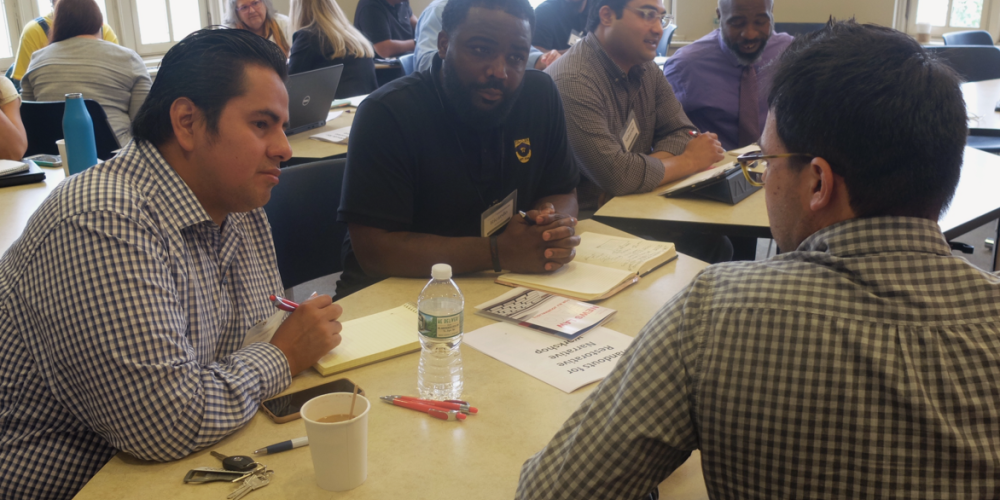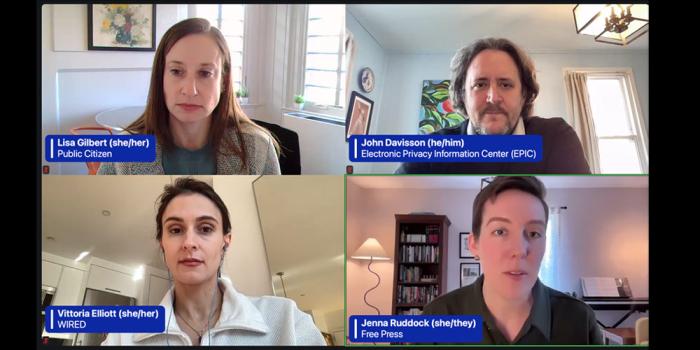Workshop Connects Atlantic City Residents and Reporters

Atlantic City’s struggles are well-known.
Once the glittering gambling capital of the East Coast, the city famously suffered from a severe economic downturn over the last decade as five of its 12 casinos shut down, 11,000 jobs were lost and the state of New Jersey took over its finances.
But that’s not the only story Atlantic City has to tell.
To change the narrative about Atlantic City and help the community heal itself and grow, in late September the Center for Cooperative Media at Montclair State University, Free Press and Images and Voices of Hope (ivoh) hosted two-dozen community members and journalists at the Carnegie Center for a workshop on restorative narratives.
Restorative narrative is best described as a “strength-based” approach to media. The term refers to journalism or storytelling that highlights the assets of a particular individual or community instead of the deficits and shortcomings.
People tell restorative narratives to evoke empathy and encourage a shift in perspective. They attempt to fully portray the life of a community and its members, resulting in stories that have much more context and depth than most traditional daily journalism.
What made this particular workshop unique was that it was initiated by people who attended Free Press’ News Voices Atlantic City event in 2015, which brought together journalists and residents to build trust and find ways to collaborate on stories that better reflected the community.
Even though that forum was nearly three years ago, the conversations and relationships stuck over time. In 2018, a small group of attendees from that gathering worked with Free Press to help brainstorm another community conversation about local news coverage, with both community members and journalists in attendance.
Inspiring hope, taking action
Free Press reached out to city residents and local reporters to figure out what the next event should focus on. It’s a complicated time right now in Atlantic City, a community that always feels like it’s about to turn a corner.
With several ongoing redevelopment projects and a changing economy coming out of a financial crisis, there was a desire to tell different stories about the community in collaboration with local media: stories that acknowledge the challenges Atlantic City faces but also showcase its strengths and possible futures.
The Center for Cooperative Media at Montclair State, which studies and promotes collaborative journalism, came on board as a partner along with ivoh, which has pioneered the restorative-narrative framework.
Ilsa Flanagan, ivoh’s executive director, led the five-hour workshop on Sept. 20. Restorative narrative is about inspiring hope and sparking action, Flanagan told the group.
“It aims to complicate our existing narratives by reminding us of the strength and resilience of our communities,” Flanagan said.
In small-group conversations, participants considered the types of stories they’ve heard about their city. Answers ranged from misconceptions about poverty and crime to narratives about an urban renaissance to pieces about broken education systems and state-run takeovers to cautionary tales about the Casino Reinvestment and Development Authority.
A common thread quickly emerged: People who live in Atlantic City often have a much different perception of the community than people who don’t.
Those negative narratives and the underlying misconceptions that fuel them, Flanagan said, are exactly the kinds of issues that restorative narratives attempt to address. In addition to common narratives on struggle and strife, it’s important to focus on shared goals and community collaboration.
Flanagan encouraged the group to work together to “create stories and drive narratives that benefit our community.”
Journalists and community members brainstorm new approaches
Getting reporters and community members into the same room was crucial to having an honest discussion, and one that was representative of a variety of perspectives about local narratives. When forming the groups, Flanagan paired reporters and editors with non-journalists. She then asked the groups to review stories from two regional news organizations, both of which had representatives in the room.
The ensuing discussion explored the kinds of calculations and priorities that shape the process of newsgathering and storytelling. Residents noted that the media often fail to tell positive stories about places like Atlantic City and tend to fall back on the cliché “if it bleeds, it leads” — an approach that can stress community members.
The journalists in the room pointed out that not every story can be positive, and that not every story is actually a story — sometimes it’s simply a basic report. They also explained how discouraging it can be to experience blowback from the community over a story they reported accurately and thoroughly, and explained how painting something as either “positive” or “negative” can sometimes simplify an issue.
One resident asked how budget cuts and layoffs have affected newsrooms’ abilities to tell better and deeper stories. This led to a respectful back-and-forth about how local media can do more to support local residents, and how local residents can do more to engage with and support local media.
After breaking down each of the pillars of restorative narratives, attendees broke into smaller groups to discuss other topics, ask questions and respond to various prompts.
Some notable responses included:
-
We need to build capacity and support place-based social structures and institutions.
-
It’s important to tell stories about people and communities coping with traumatic events (like natural disasters) or systemic social challenges (like poverty) and show them making meaningful progress from despair and difficulty to resilience.
-
Instead of underscoring what is broken, which can result in reader stress and distrust, highlight what is being built, revealing strategies for others in similar situations.
-
How do we tell stories that explore the “messy middle” of an issue, which embraces the nuance and other gray areas at play?
-
When we talk about long-term strategies to build an inclusive and sustainable Atlantic City, are the people in this room still going to be doing the things they’re doing today in 10 years?
Flanagan said that it’s crucial to be deliberate about planning and reporting a particular story. She encouraged the journalists present to ask themselves whether a given story is important to the community and to identify what questions community members might have about it.
Reporters, she said, need to build relationships with community members to tell a story, and to pinpoint the potential challenges and impacts of reporting that piece.
Community-newsroom collaborations on restorative narratives
At the end of the workshop participants agreed to carry the conversation forward and set a date for follow-up meetings. One idea that gained traction was a community-newsroom collaboration where the outlets would partner on a series of stories with the help of Atlantic City residents, and local leaders would coordinate an in-person storytelling series to bring together participants from around the city.
What is most exciting is that conversations that took place three years ago about strengthening relationships between newsrooms and Atlantic City residents continue to this day. As more and more newsrooms in New Jersey and elsewhere take steps to prioritize community engagement in their journalism, we hope that Atlantic City can serve as an example of how that process can take years to yield results.
Free Press and the Center for Cooperative Media intend to continue working with the workshop participants to bring their ideas to fruition. A sustained effort at telling restorative narratives could have a lasting impact on Atlantic City. It could lead to more community members having a voice in how stories about their community are told, and ultimately lead to local journalism playing a much different role in the city than it ever has before.




